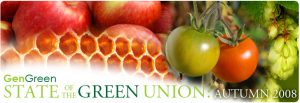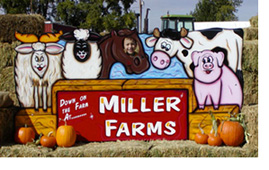
digg See past State of the Green Union reports
GenGreen is pleased to announce its State of the Green Union report for Autumn 2008. This special feature will be released seasonally and will not only highlight developing trends in the eco-sphere but will also provide information about local independent businesses and service providers demonstrating these trends across the country.
With economic issues affecting the prices and availability of food all across the country, more people are concerning themselves with how their food is grown, where it is produced and how it makes its way onto their tables. More than ever before, people are opting for locally sourced organic foods and seeking out restaurants and other food service providers that do the same. CSA’s and community gardens are popping up in cities and towns everywhere and people are getting their hands dirty for the good of the planet and each other. This is why we have chosen Organic Everything, Eat Local and Agritourism as the three greenest trends of Autumn 2008.

Despite studies that allege organic food has no health benefits over conventionally grown food and steep prices increases over the last year, organically grown foods have continued to increase in popularity. A report released in 2006 titled, Organic on the Menu: Healthy Eating Trends in Foodservice, stated that “In the last ten years, demand for organic foods has doubled and is expected to more than double again in the next few years.”
While some people may claim that “you can’t taste the difference,” organic foods are grown within strict guidelines that make sure you and the environment are protected from potentially harmful agricultural methods like spraying chemical pesticides. An article that appeared in the Boston Globe earlier this year noted that “the organic market makes up nearly 3 percent of the overall food market, a share that has increased every year for the past decade” making organically produced foods a small but fast-growing segment of an otherwise sluggish food industry. Statistics like these just verify what you already know if you visit your local grocery on at least a semi-frequent basis: it’s getting easier to find an organic version of just about everything. Even beer.

That’s right; micro-brewers dedicated to sustainable production practices are springing up all over the country. Take for instance, New Belgium Brewing in Fort Collins, Colorado. Colorado is overflowing with great brewing companies, but one would be remiss to ignore the incredible story of sustainability and philanthropy told by Fort Collins’ New Belgium Brewing Company. Armed with an amazing recipe of environmental and social responsibility mixed with employee-owned enthusiasm and selfless community involvement, its no wonder New Belgium produces some of the most delicious beers in the world. New Belgium’s beers range in flavor and style from the toasty Fat Tire Amber Ale to the zesty Mothership Wit Organic Wheat, and many intriguing small batches in between. The New Belgium facility boasts progressive green design, with its own wastewater treatment process, on-site energy production using methane, and solar lighting. Lastly, but not least, Team Wonderbike, the brewery’s bicycling advocacy program has more than 10,000 members who have pledged to offset more than eight million car miles by riding their bikes. New Belgium beers have been spotted in fine restaurants and questionable taverns nationwide, and are available at most liquor stores. www.newbelgium.com

Farther West in Humboldt County, California, Eel River Brewing is one of many small craft breweries that are proud to produce only 15 thousand barrels of beer annually. Eel River shuns the ideologies of mega-corporation breweries that only care about churning out millions of barrels of low-quality beer and instead focuses on living their motto; “Be natural. Drink naked.” Eel River was the first Humboldt County brewery to be certified organic and has won multiple awards at such prestigious events as the Great American Beer Festival and World Beer Championships. Eel River produces seven varieties of organic beer, including a Blonde Ale and Porter. www.eelriverbrewing.com

And lest we forget the Northern climates, Otter Creek Brewing in Middlebury, Vermont, and Peak Organic Brewing Company in Portland, Maine, have been producing certified organic brews since 1998- long before it was trendy in any way. The vision of both these breweries is simple: local, organic, collective, sustainable, and handcrafted, and they have been pioneers in realizing this vision since they opened. Several years ago, Otter Creek, which produces Wolaver’s Organic Ales, became the nation’s first brewery to switch their boiler fuel source from diesel to B20, effectively reducing CO2 emissions by 120,000 pounds per year. The Peak Organic Web site includes a neat feature where visitors can post images of their favorite “peak” experiences in the great outdoors. www.ottercreekbrewing.com and www.peakbrewing.com
 And if you’re not in the mood to search out microbreweries, you’ll be pleased (or surprised) to learn that even beer giant Anheuser-Busch has been dabbling in the organic beer market producing Stone Mill Pale Ale, brewed with a combination of 100 percent organic Palisade, Tradition and Hallertau hops, and 100 percent organic Metcalf and Harrington barley malts harvested from small, family-owned organic farms. Stone Mill Pale Ale is brewed by Michelob Brewing Company at an organically certified brewery of Anheuser-Busch, Inc., located in Merrimack, N.H. www.stonemillpaleale.com
And if you’re not in the mood to search out microbreweries, you’ll be pleased (or surprised) to learn that even beer giant Anheuser-Busch has been dabbling in the organic beer market producing Stone Mill Pale Ale, brewed with a combination of 100 percent organic Palisade, Tradition and Hallertau hops, and 100 percent organic Metcalf and Harrington barley malts harvested from small, family-owned organic farms. Stone Mill Pale Ale is brewed by Michelob Brewing Company at an organically certified brewery of Anheuser-Busch, Inc., located in Merrimack, N.H. www.stonemillpaleale.com

Freshness and quality have always been invaluable elements for any chef or restaurateur. And for more and more chefs across the nation, finding the best ingredients also means reconnecting with local growers. Buying locally produced foods allows you to experience the seasonal diversity of your region, helps to maintain the local economy, and means that food spends less time in transport, allowing it to retain more of its nutritional value. Since the locavore lifestyle first started gaining attention in 2005, people have been taking a look at where their food comes from and questioning why food is being shipped in from distant (or even international) growers when there are small family farms in the next valley producing marvelous produce or meats. Restaurant chefs are no exception, and as a result, restaurants across the country have begun offering menus that are chock-full of locally and sustainably sourced goodies.

Pizza Fusion proves that the words “chain restaurant,” so often uttered in disappointment, don’t have to mean low quality food. Based out of Fort Lauderdale, Florida, Pizza Fusion proudly serves up delicious, gourmet pizza in its purest form – untainted by artificial additives, like preservatives, growth hormones, pesticides, nitrates and trans fats (just to name a few). While they’re famous for pizza, their 75% organic menu features an eclectic variety of gourmet sandwiches, salads, desserts, beer and wine. But the goodness doesn’t stop there. In the interests of holding up their strong environmental mission, Pizza Fusion seeks out local and environmentally conscious vendors and suppliers and educates the general public on the importance of sustainable living through ecological community service, consumer education and environmental mentoring, like their Organics 101 course for kids. Visit their website for locations nationwide www.pizzafusion.com.

Although it is a chain of quick-serve restaurants in the Pacific Northwest, Burgerville is unique in the way it has chosen to adhere to strict environmentally and socially responsible policies. All 39 of the Burgerville locations throughout Oregon and Washington feature pastured vegetarian-fed and antibiotic-free beef, eggs from cage and antibiotic-free hens, and desserts and salads made from locally grown fruit and produce. Burgerville also purchases wind power credits equal to 100 percent of their electricity use, recycles used canola oil into biodiesel, and offers its hourly employees an affordable $15-a-month health-care plan. And they also make a pretty darn good burger. www.burgerville.com
 The incredibly unique business model of the SAME Café in Denver, Colorado, makes it the perfect example of the trend to eat locally. The brain child of a former IT professional and a teacher, the SAME (So All May Eat) Café lacks both a set menu and set prices for its dishes. Daily selections are made using fresh, organic ingredients, and funded by the donations of patrons. Instead of a cash register, a donation box is available for one to pay what they felt their meal was worth, or to leave a little more and help out someone less fortunate. If a diner does not have sufficient money to leave, they are encouraged to exchange an hour of service. The SAME philosophy is that everyone, regardless of economic status, deserves the chance to eat healthy food while being treated with dignity and that is “wonderfully different.” www.soallmayeat.org
The incredibly unique business model of the SAME Café in Denver, Colorado, makes it the perfect example of the trend to eat locally. The brain child of a former IT professional and a teacher, the SAME (So All May Eat) Café lacks both a set menu and set prices for its dishes. Daily selections are made using fresh, organic ingredients, and funded by the donations of patrons. Instead of a cash register, a donation box is available for one to pay what they felt their meal was worth, or to leave a little more and help out someone less fortunate. If a diner does not have sufficient money to leave, they are encouraged to exchange an hour of service. The SAME philosophy is that everyone, regardless of economic status, deserves the chance to eat healthy food while being treated with dignity and that is “wonderfully different.” www.soallmayeat.org

As a true pioneer in the sustainable movement, both as a restaurant and a concept, the cooperatively run Moosewood Restaurant in Ithaca, New York, had to be included on our list of eat local trendsetters. Moosewood Restaurant has operated successfully for thirty-three years and has been acclaimed as a driving force in the world of creative vegetarian cooking. It was even named one of the thirteen most influential restaurants of the 20th Century by Bon Appétit magazine! All of their meals are made with the freshest organic ingredients whenever possible, and menu options can include fresh fish and seafood, great homemade desserts, natural sodas, fresh juices, coffees, beers, spirits, and a good selection of wines from New York State and beyond. The Moosewood Collective has recently ventured outside the kitchen as well, so be sure to look for their frozen and canned foods in your local market. www.moosewoodrestaurant.com
 While it’s one thing to find a great sustainable restaurant in New York City or San Francisco, it’s quite another to find one in the middle of Iowa. But find one we did. Hailed as Iowa City’s only organic restaurant, the Red Avocado is truly dedicated to sustainable practices in all facets of its operation, from incorporating local and artisanal ingredients, using filtered water for all cooking, recycling and composting all kitchen waste, and establishing a flat rate of pay for servers and kitchen staff with tips divided equally between all those who had a hand in creating and delivering the food. www.theredavocado.com
While it’s one thing to find a great sustainable restaurant in New York City or San Francisco, it’s quite another to find one in the middle of Iowa. But find one we did. Hailed as Iowa City’s only organic restaurant, the Red Avocado is truly dedicated to sustainable practices in all facets of its operation, from incorporating local and artisanal ingredients, using filtered water for all cooking, recycling and composting all kitchen waste, and establishing a flat rate of pay for servers and kitchen staff with tips divided equally between all those who had a hand in creating and delivering the food. www.theredavocado.com

For some, just seeking out locally grown foods at the store isn’t enough. Many view these farms and ranches as wonderful bastions of sustainable agriculture and are choosing to interact farm families through a mix of environmental education and community involvement activities, sometimes referred to as agri-tourism. An agri-tourism farm is technically any land based farm or business that allows the public to view or participate in its activities. These specialized destinations generally offer things to see, things to do, and produce or gifts to buy, and can include wineries, dairies, pumpkin patches, and U-Pick Farms. Farms all across the country are opening up petting zoos, hiking trails, gift shops, corn mazes, and tours to the public as an extra revenue stream, and as a result, people are learning more about how their food is grown and gaining a sense of appreciation for the perseverance of the independent farmer.
Wilson Banner Ranch in Clarkston, Washington, is a landm

ark family heritage farm that has been sustainably run for over 100 years. Though their fruit trees were some of the first ones planted in the state, the farm has embraced many modern agricultural practices, including rotating crops with minimal till, using cover crops to discourage noxious weed infestations and integrating a pest management program which uses pheromones and many organically certified products. Their U-Pick crops are plentiful and change with the seasons, so stop on by and ask ’em what looks good. And if you can’t get out to the farm, look for their products at several local farmers’ markets. www.wilsonbannerranch.com
The Blue Tara Blueberry Farm in Poplarville, Mississippi, was started by accident in 1998 when Mandy McCormick bought the property as a retirement home where grandkids and critters could roam free. After discovering a wealth of blueberry bushes left in disarray by the previous owners, McCormick began recruiting friends and family members to help relieve the bushes of their fruit, and the rest is Pick-Your-Own history. Preferring to spend its money on fun things like tractors and pruning shears rather than chemicals and fertilizers, Blue Tara was the first farm in Mississippi to receive organic certification and has since been diligent in educating its surrounding community about responsible agriculture. www.pickaberry.com
The pristine land in upstate New York that Stone Ridge Orchard calls home has been productive, diversified farmland for nearly two hundred years. After centuries of practice, it’s understandable that the McIntosh, Cortland, Golden Delicious, and Stayman apples grown there have been called the best pick-your-own apples in the whole Hudson Valley. Their sustainable farming practices include detailed monitoring to predict insect or disease problems; eliminating the use of herbicides; substituting organic mulches for synthetic fertilizers; incorporating new, organic pest control materials into our pest management program; and continually innovating and evolving our farming philosophy. The farm has even journeyed beyond the apple world and planed sweet cherries, peaches, nectarines, plums, and Asian pears—fruits that had never even been grown in their Valley before. They’ve also added small fruits like strawberries, blueberries, gooseberries, red, yellow, and black raspberries, arctic kiwis, and even pumpkins and melons to the menu, making Stone Ridge Orchard “a veritable encyclopedia of culinary delight.” www.stoneridgeorchard.com

The recent surge of interest in agri-tourism activities has also meant that traditions like the Fall Harvest Festival are enjoying a new life. In Rochester, Minnesota, Tweite’s Fall Harvest Festival and Corn Maze has been planting memories and harvesting fun for the past 19 years. Each weekend between 09/20/2008 to 10/26/2008 visitors can enjoy 10 acres of amusements including live entertainment, wagon rides, an Enchanted Forest, the western town called Dodge City, Harvest Town with a back forty play area, more than 24,000 square-feet of permanent mazes including a six-acre corn maze, a tire dragon and the Indiana Bones Dino Dig. As a special treat, check out Tweite’s remodeled dairy barn loaded with tasty treats like homemade caramel apples, cotton candy and kettle corn, just to name a few. Gate fee charged. (Tweite’s Pumpkin Patch 1821 Frontier Rd SW Byron, MN (507) 365-8035 or www.tweite.com).
 Now in its 34th year, the Applecrest Farm Harvest Festival in Hampton Falls, New Hampshire is guaranteed to please the young and the young-at-heart. Running until the last weekend in October, the festival features free live folk and bluegrass music, “pick-your-own” apples and pumpkins, horse-drawn orchard hayrides, a children’s petting zoo, face painting, a pie eating contest, apple pie and ice cream, old-fashioned hot cider donuts, make-your-own scarecrows and a world famous corn roast. (133 Exeter Road – along Route 88, Hampton Falls, NH (603) 926-3721 or www.applecrest.com).
Now in its 34th year, the Applecrest Farm Harvest Festival in Hampton Falls, New Hampshire is guaranteed to please the young and the young-at-heart. Running until the last weekend in October, the festival features free live folk and bluegrass music, “pick-your-own” apples and pumpkins, horse-drawn orchard hayrides, a children’s petting zoo, face painting, a pie eating contest, apple pie and ice cream, old-fashioned hot cider donuts, make-your-own scarecrows and a world famous corn roast. (133 Exeter Road – along Route 88, Hampton Falls, NH (603) 926-3721 or www.applecrest.com).
 Visitors to Lattin Farms’ Fall Festival in Fallon, Nevada will find themselves lost in space and surrounded by harvest food and family activities created to celebrate the change of seasons. From the Giant Pumpkin contest to the Pumpkin Tower lighting, and moonlight mazes, there is something to entertain everyone. The farm’s corn maze, designed by the famous Adrian Fischer, is the West’s first human-sized corn maze growing in the middle of a real farm and celebrates Fallon’s centennial in 2008 (08/29/2008 – 10/31/2008). Little ones will especially enjoy the Critterville, which includes a goat walk, chicken haven and bunnyille. Kids may feed the pygmy goats hens, roosters, and turkeys as well as the bunnies. (Lattin Farms, 1955 McLean Road, Fallon, NV (775) 867-3750, 1-866 NEVMAZE (638-6293) or www.lattinfarms.com).
Visitors to Lattin Farms’ Fall Festival in Fallon, Nevada will find themselves lost in space and surrounded by harvest food and family activities created to celebrate the change of seasons. From the Giant Pumpkin contest to the Pumpkin Tower lighting, and moonlight mazes, there is something to entertain everyone. The farm’s corn maze, designed by the famous Adrian Fischer, is the West’s first human-sized corn maze growing in the middle of a real farm and celebrates Fallon’s centennial in 2008 (08/29/2008 – 10/31/2008). Little ones will especially enjoy the Critterville, which includes a goat walk, chicken haven and bunnyille. Kids may feed the pygmy goats hens, roosters, and turkeys as well as the bunnies. (Lattin Farms, 1955 McLean Road, Fallon, NV (775) 867-3750, 1-866 NEVMAZE (638-6293) or www.lattinfarms.com).
 If you’re searching for the world’s biggest pumpkins this fall, look no further: they can be found at the Half Moon Bay Art and Pumpkin Festival in Half Moon Bay, California. This year’s festival will feature a fantastic lineup: rustic pick-your-own pumpkin patches, harvest-inspired crafts, home-style foods, expert pumpkin carvers, three stages of entertainment, the Great Pumpkin Parade for children and adults willing to don costumes, a weigh-off of champion pumpkins, pie-eating contests, and a bone-chilling Haunted House. (10/18/2008 – 10/19/2008, Main Street, Half Moon Bay, CA (650) 726-9652 or www.miramarevents.com/pumpkinfest).
If you’re searching for the world’s biggest pumpkins this fall, look no further: they can be found at the Half Moon Bay Art and Pumpkin Festival in Half Moon Bay, California. This year’s festival will feature a fantastic lineup: rustic pick-your-own pumpkin patches, harvest-inspired crafts, home-style foods, expert pumpkin carvers, three stages of entertainment, the Great Pumpkin Parade for children and adults willing to don costumes, a weigh-off of champion pumpkins, pie-eating contests, and a bone-chilling Haunted House. (10/18/2008 – 10/19/2008, Main Street, Half Moon Bay, CA (650) 726-9652 or www.miramarevents.com/pumpkinfest).
 If you’re looking for a combined U-Pick-It and festival experience, you’ll find it all at Miller Farms’ Annual Fall Harvest Festival in Platteville, Colorado. With activities taking place from Labor Day until November 24th, you can take a hay ride through 180 acres of farmland where you can harvest potatoes, carrots, onions, beets, Indian corn, squash, and many other kinds of vegetables, including your very own pumpkin. There is also a corn maze, hay maze and pyramid, giant slide, fire truck, train, plane, pedal cars, and an Indian village as well as plenty of picnic tables for lunch. Miller Farms has been a working family farm since 1949 and has embraced the essence of agritourism. Farm Tours are offered year round, and are designed to help students of all ages discover how a family farm runs on a daily basis. These tours include hay rides, a petting zoo, trains, planes, automobiles, and lots of other fun educational activities for everyone. www.millerfarms.net/events.html
If you’re looking for a combined U-Pick-It and festival experience, you’ll find it all at Miller Farms’ Annual Fall Harvest Festival in Platteville, Colorado. With activities taking place from Labor Day until November 24th, you can take a hay ride through 180 acres of farmland where you can harvest potatoes, carrots, onions, beets, Indian corn, squash, and many other kinds of vegetables, including your very own pumpkin. There is also a corn maze, hay maze and pyramid, giant slide, fire truck, train, plane, pedal cars, and an Indian village as well as plenty of picnic tables for lunch. Miller Farms has been a working family farm since 1949 and has embraced the essence of agritourism. Farm Tours are offered year round, and are designed to help students of all ages discover how a family farm runs on a daily basis. These tours include hay rides, a petting zoo, trains, planes, automobiles, and lots of other fun educational activities for everyone. www.millerfarms.net/events.html

Of course there’s much more going on in the world of green that’s worthy of your attention. But for now, as the holidays and gatherings with family and friends are fast approaching, we encourage you to keep these sustainable trends in mind. Consider planning an organic meal, visiting a restaurant that serves locally sourced foods, or supporting a local farm by enjoying the bounty of the seasons at a joyous fall festival. These are easy, fun activities that allow us to reflect on the wonderful things the Earth provides for us and to appreciate the people that take the time to make sustainability happen.